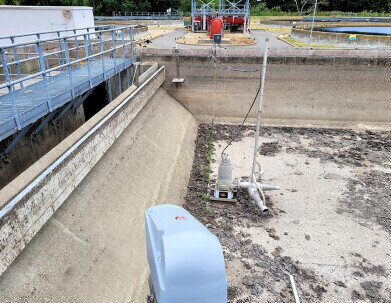Water/Wastewater
Remote cameras check storm overflows
Mar 18 2024
Following recent high levels of rainfall, and with increasing press and public attention on the factors affecting river water quality, water and sewerage companies are installing remote cameras from Meteor Communications at an increasing number of wastewater discharge and storm overflow locations. In addition to checking the veracity of event duration monitors (EDMs), the cameras are also helping to avoid unnecessary site visits, save costs, lower the carbon footprint of operations, and help identify the sources of pollution.
All water and sewerage companies (WaSCs) operating in England were instructed to install monitors on every storm overflow by the end of 2023. The purpose of these EDMs is to provide information on the frequency and duration of storm overflow spills.
According to the Environment Agency, EDM data for 2022 showed that the ten WaSCs in England have 14,580 storm overflows, and that 91% of these were fitted with EDMs. On average, each overflow spilled 23 times for an average of 5.8 hours. “However, there is concern in the industry that EDM’s can occasionally falsely indicate that a spill has taken place,” explains Matt Dibbs, MD at Meteor Communications. “EDM’s usually employ water level sensors that are either sited within the water or above it, and of course from a technical perspective, they are perfectly capable of taking accurate measurements. The problem in the field, however, is that these measurements can be affected by a wide variety of factors including overgrown vegetation, blockages, insects and cobwebs.
“In those locations where frequent spills are being reported, or when a WaSC suspects that an EDM is reporting falsely, a site visit is likely to be necessary, and it is this which has prompted a heavy demand for our remote cameras. Designed to run on low power, these are rugged, low-cost cameras that are able to deliver reliable high-quality images of discharges to verify the EDM data. With the benefit of these images, managers can make an assessment of whether a site visit is necessary, and if it is, they can determine what equipment and staff will be required.”
Meteor’s MRC cameras have been designed to operate unattended in remote locations where normal power and communications may not be available. The MRC cameras require just a small battery and a solar panel for year-round operation, and there are currently more than 2,500 of them in operation all over the UK.
In addition, Matt says: “One of the most popular features of the MRC cameras for discharge locations, is the facility to attach a reliable water level sensor so that the cameras can be automatically prompted to collect images when water levels rise.
“The MRC remote cameras therefore provide WaSCs with ‘eyes in the field’ to improve the reliability of EDM data and avoid the over-reporting of spills, while at the same time, reducing the number of site visits, saving time, lowering costs and improving the sustainability of operations by lowering the carbon footprint.”
Digital Edition
AET 28.2 April/May 2024
May 2024
Business News - Teledyne Marine expands with the acquisition of Valeport - Signal partners with gas analysis experts in Korea Air Monitoring - Continuous Fine Particulate Emission Monitor...
View all digital editions
Events
Jul 30 2024 Jakarta, Indonesia
China Energy Summit & Exhibition
Jul 31 2024 Beijing, China
2024 Beijing International Coal & Mining Exhibition
Aug 07 2024 Beijing, China
IWA World Water Congress & Exhibition
Aug 11 2024 Toronto, Canada
Aug 25 2024 Stockholm, Sweden and online









.jpg)








